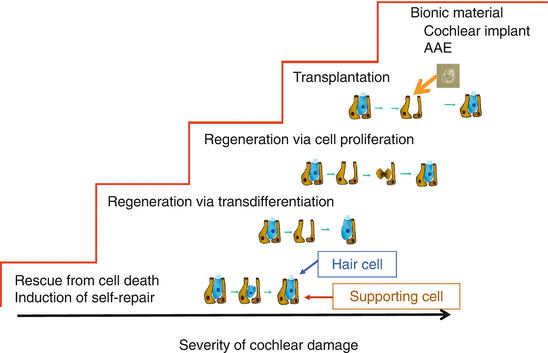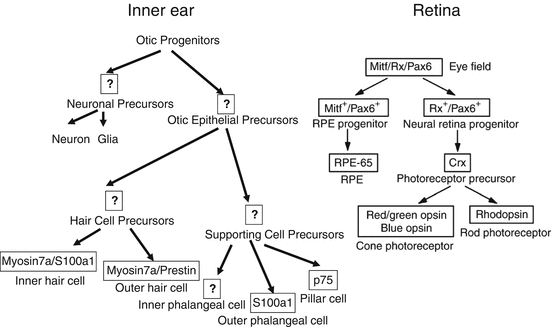Subjects: unilateral acute profound hearing loss; systemic steroid treatment application is ineffective within 1 month after deafness onset
Single application (5 mg) of IGF-1 containing hydrogel on the RWM
Observation period: 2 months
Evaluation: pure tone audiometry and OAE
After tympanostomy, the exact RWM location was confirmed using a fine 0.7-mm-diameter endoscopic fiberscope before applying IGF-1-immersed hydrogel on the RWM. Of the 25 patients recruited, the hearing ability of 15 patients (60 %) improved significantly. A clinical trial demonstrating the successful development of a novel DDS strategy for local drug delivery to the cochlea using biodegradable hydrogel is summarized (Table 33.2).
Table 33.2
Summary of a novel DDS strategy to the cochlea
Phase I–II clinical trials of local IGF-1 treatment using gelatin hydrogels for acute SNHL resistant to systemic glucocorticoid application |
Recovery of hearing ability was established in 50 % of patients |
No significant adverse drug effects were observed |
Another subject of interest was the attenuation of tinnitus. Systemic or intra-tympanic application of lidocaine has been known to be effective against tinnitus, albeit the effect was short lasting and there was the need of close risk monitoring of adverse drug effects. The aim of this study was to develop a novel DDS for sustained local delivery of lidocaine into the cochlea. Therefore, the use of lidocaine-loaded polylactic/glycolic acid (PLGA) microparticles for the sustained delivery of lidocaine in vitro and in vivo was investigated. The results of a novel delivery drug system using lidocaine-loaded PLGA microparticles are summarized in Table 33.3. Investigations of the efficacy of lidocaine in animal tinnitus models are now under way.
Table 33.3
Results of a novel delivery drug system (DDS) using lidocaine-loaded polylactic/glycolic acid (PLGA) microparticles
Lidocaine-loaded PLGA microparticles offered sustained delivery of lidocaine to the cochlea |
Mild sensitivity reduction of the auditory system |
No vestibular dysfunctions observed |
No severe inflammations in the middle ear mucosa |
33.2 Strategy 2: Regeneration via Transdifferentiation and Regeneration via Cell Proliferation
Induction of transdifferentiation, which is a possible inner ear HC regeneration strategy, has been reported by transdifferentiation of supporting cells (SCs) to HCs using Atho1-gene transfer with adenoviral vectors [5]. In our study, a chemical-genetic approach—using small molecules for regulation of targeted proteins—was adopted. Notch inhibition by gamma-secretase inhibitor was investigated in an ex vivo system. The gamma-secretase inhibitor generated numerous HCs in E17.5 mice and ectopic HCs in P3 mice in an ex vivo system. These findings suggest that possible transdifferentiation from supporting cells to hair cells by chemical agents may be established.
Induction of cell proliferation is an alternative approach to regenerate HCs. Manipulation of cell cycle regulators has been used for HC regeneration. A cyclin-dependent kinase inhibitor, such as p27, has been reported to negatively regulate the cell cycle in SCs to regenerate into HCs. Therefore, this gene therapy may serve as a possible choice for hearing loss treatment.
33.3 Strategy 3: Regeneration via Cell Transplantation
If only a few cell sources remain in the inner ear, cell transplantation becomes a possible choice to restore cell growth through regeneration. This then serves as another strategy for the development of cell therapy for the treatment of inner ear disorders. We initiated our research using rodents and embryonic stem cells (ES cells) and then progressed to primates using autologous cell sources such as bone marrow stromal cells (BMSCs) and induced pluripotent stem cells (iPS cells). There are three major target sites for cell therapy of the inner ear: (i) the auditory epithelium (especially HCs and SCs); (ii) the spiral ganglion neurons (SGNs); and (iii) the cochlear lateral wall. Note that these are crucial and sensitive sites for auditory function and their deficits result in hearing impairment (Fig. 33.1).


Fig. 33.1
Therapeutic strategies for sensorineural hearing loss
The target site (i) is the auditory epithelium, especially HCs. Recent reports have demonstrated that regeneration of the components of the sensory organs (including the retina and inner ear) can be derived from pluripotent stem cells such as ES or iPS cells. Progenitors of retinal cells are induced by inhibition of the Wnt signal and Nodal. Inner ear progenitors are also induced by the inhibition of Wnt and TGF-beta signals. These progenitors can differentiate into mature sensory cells. From the progenitors to mature sensory cells, different induction strategies are used. Although both the retinal and inner ear mature sensory cells can be derived from ES or iPS cells, their efficiencies are quite different. Among the several types of mature retinal cells, the induction efficiency of the rod photoreceptor cells is 8–25 %; however, that of inner ear HC-like cells is only 0.03 %. The efficiency difference between the retinal and inner ear cells is almost in the range of two orders. Figure 33.2 shows the schemes of cell fate specification and specific markers of the cell fates in the development of the retina and inner ear. Retinal development involves all relevant specific markers in various steps and cell types. In contrast, only a few markers are involved in the inner ear development, especially at early-stage development.


Fig. 33.2




The cell fate specification and specific markers of the cell fates in the development of the retina and the inner ear
Stay updated, free articles. Join our Telegram channel

Full access? Get Clinical Tree


